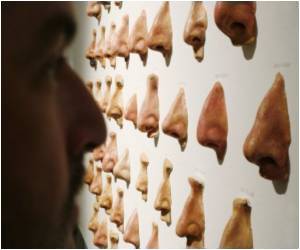Neuroscientists discovered a genetic trigger that makes the nose renew its smell sensors, new therapies for people who have lost their sense of smell due to trauma or old age.

"Anosmia the absence of smell is a vastly underappreciated public health problem in our aging population. Many people lose the will to eat, which can lead to malnutrition, because the ability to taste depends on our sense of smell, which often declines with age," said lead researcher and campus neuroscientist John Ngai.
"One reason may be that as a person ages, the olfactory stem cells age and are less able to replace mature cells, or maybe they are just depleted," he said. "So, if we had a way to promote active stem cell self-renewal, we might be better able to replace these lost cells and maintain sensory function."
Gary K. Beauchamp, director of the Monell Chemical Senses Center in Philadelphia, who was not a member of the research team, noted that the olfactory system stands out for its ability to regenerate following injury or certain diseases
"This new paper … presents an elegant analysis of some of the underlying genetic mechanisms regulating this regeneration," Beauchamp said. "It also provides important insights that should eventually allow clinicians to enhance regeneration, induce it in cases where, for currently unknown reasons, olfactory loss appears permanent, or even prevent functional loss as a person ages."
The discovery may also help scientists harness olfactory stem cells and stem cells found in other sensory systems more generally, to recover sensory function following injury or degenerative disease, said Ngai, the Coates Family Professor of Neuroscience in UC Berkeley's Department of Molecular and Cell Biology and director of the Helen Wills Neuroscience Institute and the QB3 Functional Genomics Laboratory.
Advertisement
Self-renewal or differentiation
Advertisement
"These stem cells are capable of reconstituting the entire sensory epithelium of the nose following injury," Ngai said, "so understanding how these stem cells work is important for understanding the regeneration process that goes on in the nose."
Fletcher and Ngai screened nose epithelial cells for regulatory genes and discovered one, called p63, that was a previously known transcription factor that acts by controlling the transcription of other regulatory genes in epithelial stem cells, such as those in the skin, the lining of the airways and the prostate. By knocking out the p63 gene in mice, they showed that nasal olfactory stem cells rapidly differentiated into sensory neurons at the expense of the stem cells themselves.
"This gene produces a molecule that is like a brake on the stem cell," Fletcher said. "When the brake is on, stem cells self-renew. If you remove the brake, the stem cells go into differentiation."
A drug that regulates p63, or modulates one of the genes that p63, in turn, regulates, might be able to boost the number of nasal stem cells as well as the number that mature into smell neurons.
Because p63 is found in many epithelial tissues, Ngai noted, these findings could be applied to other adult tissue stem cells including stem cells in the skin and possibly lead to future therapeutic "cell replacement" strategies to take the place of damaged or dead cells not only in the nervous system but in other epihelial tissues in the body.
Source-Eurekalert









